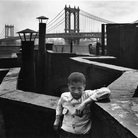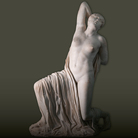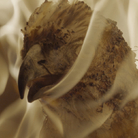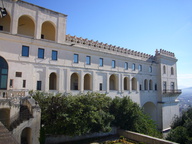Paradossi. Incontri inattesi tra Antico e Contemporaneo. Le lesene di Giulio Aristide Sartorio e l’installazione sonora di Alberto Tadiello

Alberto Tadiello, Tararaxacum, Installazione sonora
Dal 17 October 2014 al 18 January 2015
Venezia
Luogo: Ca’ Pesaro - Galleria Internazionale d’Arte Moderna
Indirizzo: via Santa Croce 2076
Orari: 10-18; dal 1° novembre 10-17
Costo del biglietto: intero € 10, ridotto € 7.50, scuole € 4
Telefono per informazioni: +39 041 721127
E-Mail info: capesaro@fmcvenezia.it
Sito ufficiale: http://capesaro.visitmuve.it
Grazie al restauro reso possibile da Dom Pérignon, la Galleria Internazionale d’Arte Moderna di Ca’ Pesaro a Venezia apre un suo nuovo spazio dedicato all’incontro tra giovani artisti e opere che fanno parte della collezione storica: una serie che offre la visione di “Paradossi“, incontri inattesi tra l’arte dei nostri giorni e quella del XIX – XX secolo.
La mostra sarà ospitata all’interno del nuovo “Spazio Dom Pérignon” dal 17 ottobre 2014 al 18 gennaio 2015.
Lo spazio si propone come una singolare « project room » in cui si mescolano e si contaminano a vicenda il «vecchio» e il «nuovo».
L’idea di una tale serie di presentazioni viene dalla Fondazione Musei Civici di Venezia, diretta da Gabriella Belli che, con l’architetto Daniela Ferretti, ha progettato la riapertura di queste due straordinarie sale che si affacciano sul Canal Grande.
La serie “Paradossi” e la mostra che la inaugura sono a cura di Angela Vettese.
Per l’apertura dello “Spazio Dom Pérignon”, il giovane artista vicentino Alberto Tadiello (1983) si misurerà con l’imponente opera di Giulio Aristide Sartorio (1860-1932), i cui teleri intitolati Il Poema della vita umana – ciclo pittorico realizzato per la Biennale d’Arte del 1907 – raffigurano le allegorie de La Luce, Le Tenebre, l’Amore e La Morte intramezzate da dieci pannelli verticali (le Cariatidi, che rappresentano la Grazia e l’Arte sorrette dall’energia virile).
Attraverso queste opere l’artista ha voluto proporre una visione altamente drammatica dell’esistenza. Una complessa iconografia, approvata anche da D’Annunzio, che appare come la sintesi tra mondo mediterraneo e cultura nordica, con evidenti richiami alla concezione dell’eterno ritorno di Nietzsche.
Privo di elementi architettonici e risolto in monocromia, il ciclo pittorico si segnala per l’eccezionale dispiegamento di figure in movimento dal chiaro intento simbolico.
Tadiello compenetra il suo intervento con lo straordinario lavoro di Sartorio, quasi a farne un’unità nuova.
Le opere di Tadiello nascono sempre dal tema della diffusione dell’energia. In questo caso l’incipit di una composizione musicale è stato registrato e ripetuto molte volte in modo sfalsato, come a mostrare il risultato di una torsione.
I lavori del giovane artista vicentino, infatti, assumono spesso l’aspetto di interventi sonori, in cui diventano sculture proprio gli elementi tecnici che servono a generare il volume acustico.
Le opere sottolineano il valore della tensione, come modo per rendere esplicito l’impegno, così come l’entusiasmo: una maniera di porsi di fronte all’esistenza che non ha nulla di banale o leggero, ma anzi calza con l’esigenza di compenetrarsi nella fatica fruttuosa della natura, nel modo in cui fluiscono in essa fasci di attività, suono, linfa.
Dal rapporto di dipendenza con la natura nascono anche il ricorrere frequente del “brusio”, del “frinire”, della “ripetizione sonora”, così come della “simmetria formale”: è così che dobbiamo comprendere “margherite” di altoparlanti, “raggi” di fili elettrici e il rincorrersi dei rumori come “richiami” e “respiri”.
La mostra sarà ospitata all’interno del nuovo “Spazio Dom Pérignon” dal 17 ottobre 2014 al 18 gennaio 2015.
Lo spazio si propone come una singolare « project room » in cui si mescolano e si contaminano a vicenda il «vecchio» e il «nuovo».
L’idea di una tale serie di presentazioni viene dalla Fondazione Musei Civici di Venezia, diretta da Gabriella Belli che, con l’architetto Daniela Ferretti, ha progettato la riapertura di queste due straordinarie sale che si affacciano sul Canal Grande.
La serie “Paradossi” e la mostra che la inaugura sono a cura di Angela Vettese.
Per l’apertura dello “Spazio Dom Pérignon”, il giovane artista vicentino Alberto Tadiello (1983) si misurerà con l’imponente opera di Giulio Aristide Sartorio (1860-1932), i cui teleri intitolati Il Poema della vita umana – ciclo pittorico realizzato per la Biennale d’Arte del 1907 – raffigurano le allegorie de La Luce, Le Tenebre, l’Amore e La Morte intramezzate da dieci pannelli verticali (le Cariatidi, che rappresentano la Grazia e l’Arte sorrette dall’energia virile).
Attraverso queste opere l’artista ha voluto proporre una visione altamente drammatica dell’esistenza. Una complessa iconografia, approvata anche da D’Annunzio, che appare come la sintesi tra mondo mediterraneo e cultura nordica, con evidenti richiami alla concezione dell’eterno ritorno di Nietzsche.
Privo di elementi architettonici e risolto in monocromia, il ciclo pittorico si segnala per l’eccezionale dispiegamento di figure in movimento dal chiaro intento simbolico.
Tadiello compenetra il suo intervento con lo straordinario lavoro di Sartorio, quasi a farne un’unità nuova.
Le opere di Tadiello nascono sempre dal tema della diffusione dell’energia. In questo caso l’incipit di una composizione musicale è stato registrato e ripetuto molte volte in modo sfalsato, come a mostrare il risultato di una torsione.
I lavori del giovane artista vicentino, infatti, assumono spesso l’aspetto di interventi sonori, in cui diventano sculture proprio gli elementi tecnici che servono a generare il volume acustico.
Le opere sottolineano il valore della tensione, come modo per rendere esplicito l’impegno, così come l’entusiasmo: una maniera di porsi di fronte all’esistenza che non ha nulla di banale o leggero, ma anzi calza con l’esigenza di compenetrarsi nella fatica fruttuosa della natura, nel modo in cui fluiscono in essa fasci di attività, suono, linfa.
Dal rapporto di dipendenza con la natura nascono anche il ricorrere frequente del “brusio”, del “frinire”, della “ripetizione sonora”, così come della “simmetria formale”: è così che dobbiamo comprendere “margherite” di altoparlanti, “raggi” di fili elettrici e il rincorrersi dei rumori come “richiami” e “respiri”.
SCARICA IL COMUNICATO IN PDF
COMMENTI

-
 Dal 2 December 2025 al 19 February 2026
Milano | Centro Culturale di Milano
Dal 2 December 2025 al 19 February 2026
Milano | Centro Culturale di Milano
Walter Rosenblum. Il mondo e la tenerezza
-
 Dal 30 November 2025 al 12 April 2026
Gallarate | Museo MA*GA
Dal 30 November 2025 al 12 April 2026
Gallarate | Museo MA*GA
Kandinsky e l’Italia
-
 Dal 29 November 2025 al 12 April 2026
Roma | Musei Capitolini
Dal 29 November 2025 al 12 April 2026
Roma | Musei Capitolini
La Grecia a Roma
-
 Dal 22 November 2025 al 3 May 2026
Torino | Sale Chiablese dei Musei Reali
Dal 22 November 2025 al 3 May 2026
Torino | Sale Chiablese dei Musei Reali
Orazio Gentileschi. Un pittore in viaggio
-
 Dal 20 November 2025 al 25 January 2026
Firenze | Palazzo Strozzi
Dal 20 November 2025 al 25 January 2026
Firenze | Palazzo Strozzi
Andro Eradze. Bones of Tomorrow
-
 Dal 21 November 2025 al 28 March 2026
Cuneo | Complesso Monumentale di San Francesco
Dal 21 November 2025 al 28 March 2026
Cuneo | Complesso Monumentale di San Francesco
La Galleria Borghese. Da Raffaello a Bernini. Storia di una collezione


